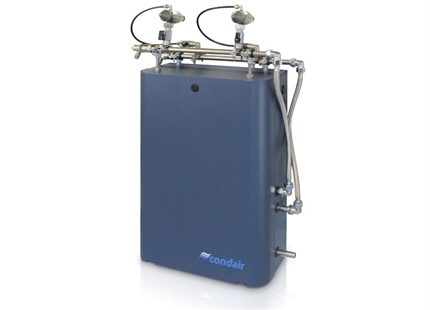19.01.2018
Condair launches "Humidity Fights Flu" campaign
Humidification specialist, Condair, is launching a “Humidity Fights Flu” campaign to promote awareness that an indoor humidity level of 40-60%RH is very beneficial in combating airborne influenza infections.
Tim Scott, head of sales at Condair plc, comments, “There is overwhelming scientific evidence that person-to-person airborne flu infections are significantly reduced when indoor humidity is maintained at 40-60%RH. Yet there is still no legislative requirement for public places or healthcare facilities to manage their humidity levels appropriately and take advantage of this effective weapon in the fight against seasonal flu.
“The building services sector should not just accept this as an inevitable blight on our society every winter and ought to be doing more to address the spread of seasonal influenza through humidity control. Without humidification most indoor environments will drop below 40%RH for a substantial duration during the winter. It is in this dry danger zone that infectious airborne flu germs survive for many hours. It has been proven that maintaining a room’s air at above 40%RH results in the airborne flu virus becoming deactivated five times faster, which results in a significant reduction in cross-infections, less absenteeism and improved occupant health.”
As part of its Humidity Fights Flu campaign, Condair has published the summaries of 24 scientific studies on its website, which show the effect humidity has on health. The research on www.condair.co.uk/fighting-flu shows three humidity-related processes that inhibit the spread of airborne respiratory infections. Firstly, that when an infected person breathes, sneezes or coughs-out infectious particles, fewer of them remain airborne if the air is above 40%RH. Secondly, at 40-60%RH those remaining infectious airborne germs are rapidly deactivated due to chemical reactions with the salts and proteins contained within their host airborne droplet. Lastly, the studies show that our respiratory system’s defence against airborne infection operates significantly better at between 40-60%RH.
Seasonal flu peaks when indoor humidity levels are at their lowest. Indoor environments where people are forced together for prolonged periods, like schools and educational establishments, offices and healthcare facilities are core battlegrounds in the spread of seasonal infections. This is particularly true of hospitals and GP surgeries where infected individuals are brought into close proximity with susceptible individuals.
A sharp rise in the cases of flu seen by GPs across England in the early weeks of 2018 suggest it could be the worst flu season for seven years. Nearly 22,000 people went to their GP with flu in the first week of 2018, according to the Royal College of GPs, and around 5,000 people were admitted to hospital, based on Public Health England figures for 22 out of 137 trusts. Similar trends have been seen in Scotland and Wales, with just over half of circulating strains believed to be the H3N2 strain known as “Aussie flu”, after problems the virus caused in Australia’s last winter.
Tim Scott, continues, “Even putting aside the building services sector’s moral obligation to protect the health of its buildings’ occupants, humidity control for health makes obvious financial sense. Staff costs typically account for 90% of business expenditure and respiratory infections are the primary cause of short term absenteeism. Combine this cost to the business economy with the financial burden seasonal flu has on our health service and the cost of humidity control as a preventative measure in offices, educational and healthcare facilities pales into insignificance.”
Alongside the promotion of the scientific research, Condair’s Humidity Fights Flu campaign will see free desktop hygrometers being offered to people working in offices, education and healthcare, so that they can monitor their indoor humidity levels and report their results to Condair. A similar survey of over 290 HVAC consultant and contractor offices across the UK and Ireland, carried out by Condair in 2017, saw that some offices were as low as 20%RH, with the average office being below the industry’s recommended level at just 38%RH.















